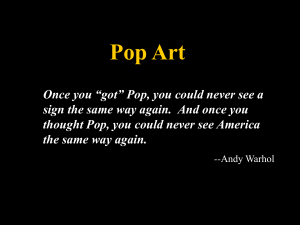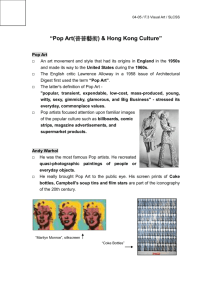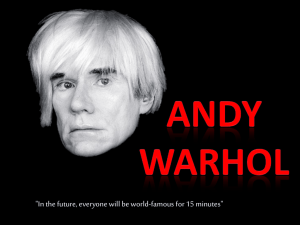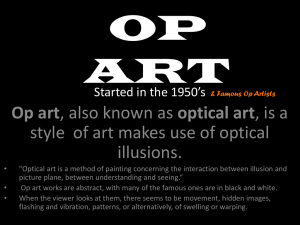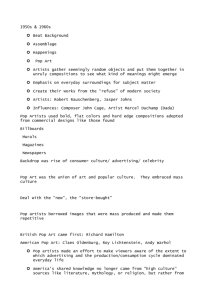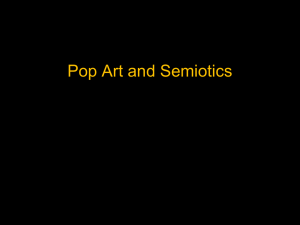Pop Art - e-artlab
advertisement
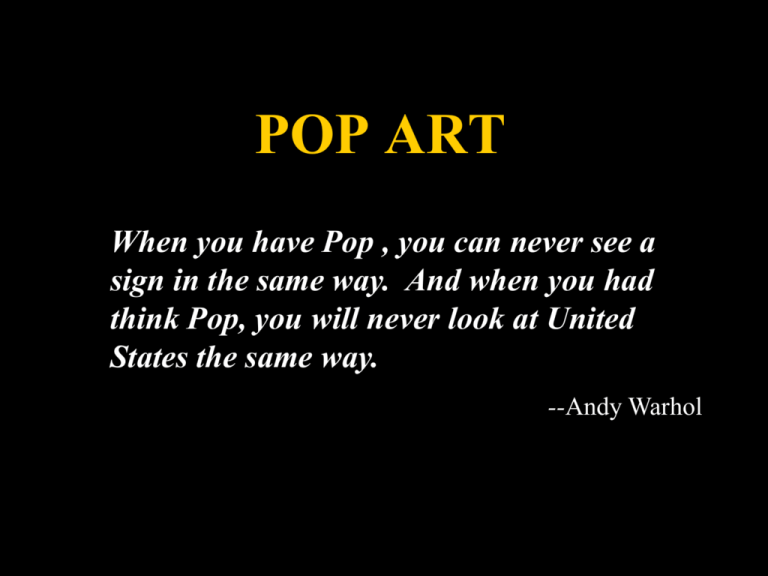
POP ART When you have Pop , you can never see a sign in the same way. And when you had think Pop, you will never look at United States the same way. --Andy Warhol Pop Art Pop Art was an artistic movement developed at the end of 1950´sand begining of the 60´s, was a reflect of the quotidean life and common objects. Brillo Soap Pads Box, 1964, AWF “Pop artists made images out of anything anyone could recognize on the streets in one second. . .”—Gretchen Berg. Three Coke Bottles, 1962, AWF Jackson Pollock, Number 4, 1950 Carnegie Museum of Art; Donación de Frank R. S. Kaplan/ARS Pop artists get away from the Abstract Expressionism, the artistic style that was on “fashion” on the late 50´s. The Expressionists evoque emotions, feelings and ideas through the formal art elements: • Line • Color • Shape • Form • Texture Pop artists used common images of the quotidian culture, including: • Propaganda • Comsumism • Celebritys • Photographs • Comics Roy Lichtenstein, Masterpiece, 1962 Artists used bright colors, plain and compositions adapted from comercial designs as those found on: •Cardboards • Murals • Magazines • Diaries Campbell's Soup II, 1969, AWF Pop artists showed their culture , 60´s using new materials in their artistis work, which include: •Acrilic painting • Plastics • Photographs • Metalic and fluorescent colors Robert Rauschenberg, Retroactive II, 1963 As well as new tecnologies and methods: • Mass production • Fabrication • Photography • Engraving • Series Claes Oldenburg, Floor Burger 1962, Claes Oldenburg Pop art brought the attention of many spectators, even thoigh they feel they were moking common people and their lives. It was hard for some people to understand why artists painted cheap objects, quotidian, when historically the function of art was to represent the ideals more valuable of culture. Listerine Bottle, 1963, AWF Andy Warhol was one of the most famous artists of the Pop culture. He used new technologies and new ways of making art which include: • Photographic silk screen • Repetition • Mass Production • Colaboration • Mediatic Events Andy Warhol, Brillo Boxes installation, Warhol took (without autorization) images of diaries, magazines, and photographs of newspapers of the most popular characters of his time ©2006 Life Inc. Silver Liz [Ferus Type], 1963, AWF Warhol used repetition of mediatic events to critisize cultural ideas through his art Pinturas Jackie, 1964, AWF Warhol took equotidian lements and geve them the importance as “art” Knives, 1981, AWF Brillo Soap Pads Box, 1964, AWF What makes and art piece better than another? Pop artist took further the definition of What can be artand how could it be done Fotografía de Hervé Gloaguen “The pop idea , after all, was that anybody could make anything; naturally, then everybody tryed to make it all…” ---Andy Warhol The actual world of art shows many ideas, methods and materials started by the artistic movement Pop. En Untitled, 1991, Barbara Kruger uses the iconography of the United States flag and graphics to ask a series of provocative questions about the USA culture and its values. Barbara Kruger, Untitled, 1991 Cortesía de: Mary Boone Gallery, NY En Rabbit, 1986, by the artist Jeff Koons, mass production. This sculpture was an icon in hte 80´s. Jeff Koons, Rabbit, 1986, Jeff Koons
